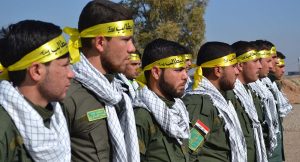Iran is increasing its efforts to change the identity of Sunni-majority Syria, with the aim of establishing a long-term influence inside the country, like reported by chathamhouse.org.
It has brought in fighters from the Middle East region and beyond. The Lebanese Hezbollah was among the first to arrive, and Iranian revolutionary guards, Afghan, Pakistani, Yemeni and Iraqi Shia militias are among the fighters that Iran has been relying on in gaining control in Syria. It has also organized and trained the local Syrian para-militia known as National Defence Forces, whose members were first known as ‘Shabiha’, who became notorious for beating up protesters in the streets.
Local fighters proved unreliable for Iran, often seeking to enrich themselves at the expense of military or ideological goals. Iran has instead relied on imported fighters like Hezbollah and the Iraqi militia of Abou Fadel Al Abbas, whose religious and ideological motivations have made them more loyal.
Iran is also engaged in a process of demographic change, at least around the city of Damascus, aimed at surrounding the city with Iran loyalists. Shia in Syria comprise less than one per cent of the population – even large numbers of new arrivals cannot dominate. But they can change the balance of power. Iran is now installing loyalist Shia in areas around Shia shrines and surrounding Damascus, mainly the areas leading to Lebanon, so that Iran can secure a contiguous route for Hezbollah.
Residents of Damascus are speaking more and more about wealthy Shia buying properties in the city. New arrivals from Kefraya and Foua, the two Shia towns in Idlib that were part of a Qatari-brokered population exchange deal with the Sunni towns of Madaya and Zabadani, have now relocated to areas surrounding Shia shrines in both Sayyeda Zainab and Sayyeda Rouqayaa in the heart of the old city Damascus.
The latter shrine is for Ali bin Abi Taleb’s granddaughter, who died at four and was buried behind the Sunni Umayyad mosque. The shrine has now been expanded and turned into a hussainiyya, a Shia religious centre, with an architecture that is a replica of a mosque in Isfahan with blue tiles. Its construction has resulted in the demolishment and disfiguring of historical buildings that are hundreds of years old and are supposed to be on UNESCO’s heritage list.
Many of the area’s non-Shia residents are expressing anger about Iran’s imposition of Shia religious culture, and many Sunnis in Damascus say they are feeling increasingly isolated and powerless. Even Alawite loyalists to the regime are not happy. Although they want to see the Assad regime stay in power, they are not comfortable with the religious influence Iran is trying to enforce on Syria.
This religious influence has been a strategic aim for Iran. It has been building around existing shrines for decades, and has bought loyalty with money, changing the religious character of villages in Raqqa, Aleppo and elsewhere in Syria. But among the Alawites, who are not so religiously conservative, Iran has not succeeded. In some Alawite villages, where there were attempts to build Shia religious shrines with Iranian money, people who tried to do so were expelled from the villages.
To some extent, both regime loyalists and the Syrian opposition are wary of Iran’s efforts to change the religious identity of Syria, worried about it bringing in a Shia kind of extremism. Both sides reject it, and at least in Damascus, many prefer Russia to Iran. The ex-Soviet country has no interest in imposing any extremist religious ideology or changing the social fabric of Syria, already damaged by the war.



